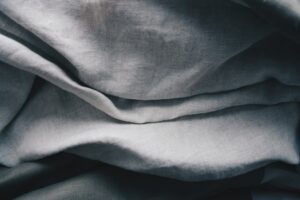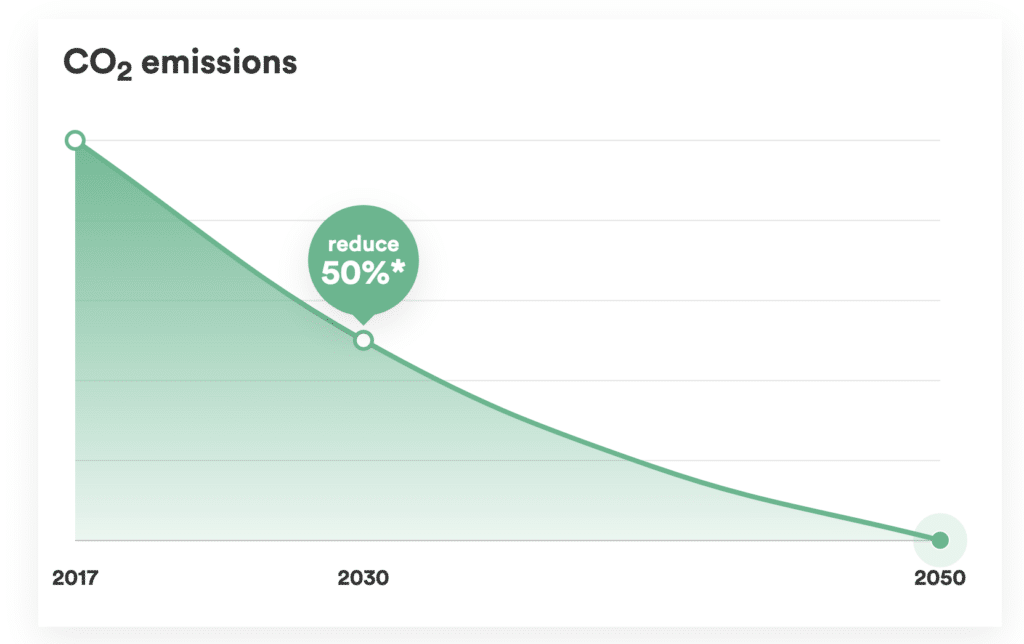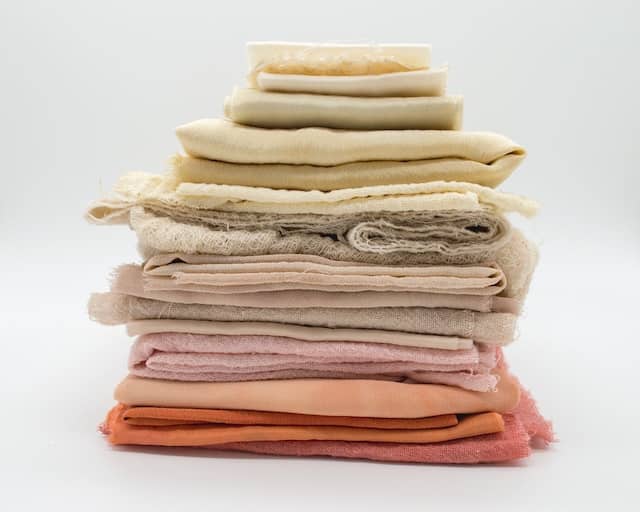Introduction to Tencel – a wood cellulose fabric
Consumers are interested in Tencel environmental benefits. We’ll explain why here. Tencel is a brand of textile produced by Lenzing AG, a very large Austrian company with global operations. The fiber is made from the wood pulp of trees that is claimed to be sustainably and responsibly sourced, making it a potential eco-friendly choice for consumers.

Tencel fabric is reviewed as being soft, absorbent, and breathable, making it a popular for clothing and bedding. It is also resistant to wrinkles and static and can be washed and dried without needing ironing. It gets labeled often as a “luxury fabric”.
Certainly it’s more expensive to produce. Whether its luxury or not depends on the customer. In all, Tencel piques our interests as carbon conscious consumers to consider as a fabric that has the potential to reduce carbon impact of clothing and functionally positive at the same time.
Tencel and carbon neutrality
The product line and the parent company Lenzing both tout that Tencel is on its way to becoming carbon neutral on this Tencel carbon neutrality pledge page.
However, the product line is not carbon neutral yet – in fact, based on the website’s proposal you’d have to wait until 2030 for the carbon cost to go down by 50% and then another 20 years for it to go to zero.
On the other hand the company has announced that one of its product lines, “Carbon neutral fibers” is accessible now in a press release. To us this is unclear if all Tencel is carbon neutral or if its a narrower line within Tencel products that use these carbon neutral fibers.
To us, this is a positive sign if even a single product is truly carbon neutral. The best way to find out would be if Lenzing or an independent party carried out an analysis of its process and compared it with a close competitor.
At the moment, its unclear beyond the company’s claim whether this product is better for carbon reduction than its competing fabrics, including simple cotton. This is because all of these fabrics ultimately draw carbon from the atmosphere and embeds it into the material – i.e. the composition of fabrics is carbons linked together.
All of these products ultimately must account for lifecycle emissions, from the energy used for harvesting, to processing, and to transport and sales.

Tencel would benefit from independent emissions review
Ways to reduce the carbon emissions include responsible sourcing, i.e. from farmed lumber, to use of renewable energies in the processing of the material to use of chemicals derived from low carbon intensity processes.
It actually is quite similar to another fabric called “rayon” – also derived from wood cellulose and very widely known for being an “artificial” fabric. The difference is as we noted that Tencel is supposed to use less energy than rayon to manufacture.
As a comparator, take a look at OpenCO2’s record of rayon carbon emissions. The value is given as 14 kg/kg, meaning that 14 kg of CO2 are emitted for each kg of rayon manufactured. It would be super useful for consumers to know if a similar accounting for Tencel shows that its indeed zero or lower or even at least better than rayon. Similarly, looking at OpenCO2’s record of cotton carbon emissions shows a value of 14.5 kg/kg, which is quite similar to rayon.
What are the claimed Tencel environmental benefits
Tencel is a naturally derived fiber made from wood cellulose. Tencel production is said to be environmentally friendly because it requires less energy and water than competing textiles fibers, and the resulting product is biodegradable. Tencel fabrics are also soft and absorbent, making them comfortable to wear.
Here are 4 claimed environmental benefits of Tencel:
1.Tencel Is Sustainable
Tencel is said to be a sustainable fabric that is made from wood pulp. The wood pulp is harvested from trees grown in sustainably managed forests. Tencel is then produced using a closed-loop process that recycles all the water and chemicals used in the production process. Tencel is also biodegradable, meaning it will break down into harmless substances when disposed of.
Tencel is an extremely versatile fabric for various products, including clothing, upholstery, and bedding. Tencel is also soft and absorbent, making it ideal for use in towels and sheets. Tencel’s unique combination of sustainability, versatility, and comfort makes it an excellent choice for various applications.
2.Closed Loop Production Process
Closed loop production guarantees that no waste is emitted into the environment. Tencel, a type of fabric, undergoes a closed-loop production process where all solvents and emissions are constantly recycled. This not only eliminates pollution but also conserves water and energy. Closed loop production is a more efficient way of producing Tencel because it requires less water and energy to recycle the solvents and emissions. Additionally, this process creates a much higher quality Tencel fabric that is softer and more durable. As a result, the closed-loop production process is better for the environment and results in a higher quality product.
3.Recycled Water And Chemicals
Tencel, also known as lyocell, is a sustainable fabric made from wood pulp. It’s often touted as more environmentally friendly than other fabric types, such as cotton or polyester.
One of the reasons for this is that Tencel can recycle water and chemicals. The process of making Tencel is closed-loop, meaning that the water and chemicals used are reused repeatedly. This helps to reduce the amount of waste produced during the manufacturing process. Similarly, hemp is often cited as a “low water-use” fabric.
In addition, Tencel requires less water and energy to produce than other fabrics. As a result, it has a smaller carbon footprint. Tencel is also biodegradable, which will eventually break down into harmless substances when disposed of.
4.Biodegradability
Biodegradability is the ability of a substance to be broken down by living organisms, typically over weeks or months. This process is essential for the recycling of nutrients in the environment. Biodegradable materials, such as Tencel, are an important part of sustainable living. Biodegradability by itself doesn’t guarantee carbon reduction, but studies show that diverting trash from landfills reduces methane burden so if this is pushed into your composting bin for example you might be able to fix the carbon via the composting process.
If Tencel were biodegradable it adds to its good qualities as a sustainable fabric.

Why Is Tencel so expensive?
Tencel is a type of fabric made from cellulose fibers. It is known for being environmentally friendly and extremely soft. However, it is also one of the more expensive fabric types on the market. Why is Tencel so expensive?
There are a few reasons for this. First, Tencel is made from cellulose fibers, which are not as widely available as other fabric materials. This makes the fabric more difficult and costly to produce. In addition, Tencel has often been considered a luxury fabric due to its environmental friendliness and exceptional softness. As a result, it is typically priced at a higher point than other fabrics. Finally, Tencel is often used in high-end fashion garments, contributing to its higher price tag.
Despite its cost, Tencel remains a popular choice for many people due to its unique properties. If you are looking for luxurious and environmentally friendly fabric, Tencel may be the right choice for you. However, be aware that you will likely pay a bit more for this fabric than you would for other types of fabric.
Wrapping up on Tencel environmental benefits
In conclusion, Tencel is a good choice for the clothing consumer. From the get go its a fabric made from cellulose fiber known for being soft, durable, and easy to care for. What’s not so clear yet is whether the carbon intensity is lower than its competitor, if its zero as claimed. Tencel is also one of the more expensive fabric options on the market.
You can also read:
What Is An Edible Water Bottle?
What Is Biodegradable Packaging?
